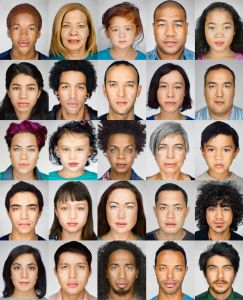 National geographic writer, Lise Funderburg decibels how by 2050, the average person will not be strictly white or black, but more multiracial. The expectation of more multiracial people comes from data collected by the U.S. Census Bureau, which has collected detailed data on multiracial people only since 2000, when it first allowed respondents to check off more than one race, which applied to 6.8 million people. Within the past ten years, that number has increased by 32%. Funderburg describes giving the option for people to check more than one race as “ a step toward fixing a categorization system that, paradoxically, is both erroneous (since geneticists have demonstrated that race is biologically not a reality) and essential (since living with race and racism is). The tracking of race is used both to enforce antidiscrimination laws and to identify health issues specific to certain populations”.
National geographic writer, Lise Funderburg decibels how by 2050, the average person will not be strictly white or black, but more multiracial. The expectation of more multiracial people comes from data collected by the U.S. Census Bureau, which has collected detailed data on multiracial people only since 2000, when it first allowed respondents to check off more than one race, which applied to 6.8 million people. Within the past ten years, that number has increased by 32%. Funderburg describes giving the option for people to check more than one race as “ a step toward fixing a categorization system that, paradoxically, is both erroneous (since geneticists have demonstrated that race is biologically not a reality) and essential (since living with race and racism is). The tracking of race is used both to enforce antidiscrimination laws and to identify health issues specific to certain populations”.
The Census Burea is aware that racial categories are flawed instruments, disavowing any intention “to define race biologically, anthropologically, or genetically.” And indeed, for most multiple-race Americans, including the people pictured here, identity is a “highly nuanced concept, influenced by politics, religion, history, and geography, as well as by how the person believes the answer will be used”. Whatever ethnicity provides a situational advantage most people tend to respond with that race and loyalties figure in too, especially when one’s heritage doesn’t show up in phenotypical facial features, hair, or skin. Even though in the past years the number of multiracial people have increased, race is still a major issue in America. People are becoming more open to interracial marriages, but there will still be barriers, such as poverty that hold back the minority races. In 2050 it is expected that the non- Hispanic white race will no longer make up the majority of the world’s population and this could lead to many changes in society that benefit other races. Barriers that have been placed on the minority races could possibly be broken and problems that have arisen in 20 15 could possibly co
15 could possibly co
me to an end. Here is the rate of interracial marriages in the United States overtime:
1959 – 4 percent
1971 – 29 percent
1982 – 43 percent
1995 – 48 percent
2008 – 77 percent
2013 – 87 percent
As of 2015, 2050 is in 35 years, and I do not believe the average in the United States will look like this. From the statistics, the rate at which interracial marriage are occurring is increasing, as well as the births of interracial children, but I do not find it justifiable that this will be the representation of an average citizen.

So it looks like I’m going to have to be the guy who references South Park as a legitimate talking point here. But anyhow, the premise that we are all becoming more similar is a naturally reachable evolutionary endpoint. With the world becoming smaller through increased travel and interaction, it is easy to understand that the evolutionary traits we developed would be erased. But of course it would take a ton of time to happen, and it could be reversed by spreading out again.
This is an interesting post because I’ve seen this picture on the National Geographic magazine cover multiple times before and was surprised by the claim they were trying to present. I agree with you that 35 years is too short of a time frame for the majority of people to look like the girl pictured. There is a huge increase in interracial couples in society today, since we are such a diverse country. I have no doubt that the amount of multicultural people will outweigh Caucasians in the U.S. eventually, it just might take longer than they predicted.
I agree completely. As we’ve learned in class, journalists and magazines tend to blow scientific findings was out of proportion. One small correlation or statistic and they’re out spreading the news of some huge scientific finding that was never fully proven. Though I do believe that in the future, many more people will look that way due to generations of interracial couples of all kind, I’m not on board with their numerical predictions.